#toarcian
Text

Please welcome Franconiasaurus brevispinus!
A new plesiosaur from the early Jurassic of Germany and a important missing link in plesiosaur evolution! Congratulations to the three authors, here the paper for those who haven't seen it
I have a rather personal connection to this specimen because me and Sven were on a road trip to the EAVP meeting in Munich when we came across this fossil in Bayreuth. It was quite the surprise walking into the collection and finding this, already largely out of the matrix.

It was quite funny to see Sven dive right in and after roughly 15 min of looking at it proclaiming, "pretty sure that's a new genus", I think we had a name for it already on the drive back
Franconiasaurus wasn't an apex predator, that time hadn't come yet for plesiosaurs, but it fills an important evolutionary gap between basal and more derived plesiosaur clades of the Jurassic. Here a little overview of animals that lived with it. This formation, the Jurensismergel, isn't as productive as the underlying Posidonia shale, but it's also a thinner, and less studied formation. Quite a few fossils still await a proper description or a name. These Temnodontosaurus for example.
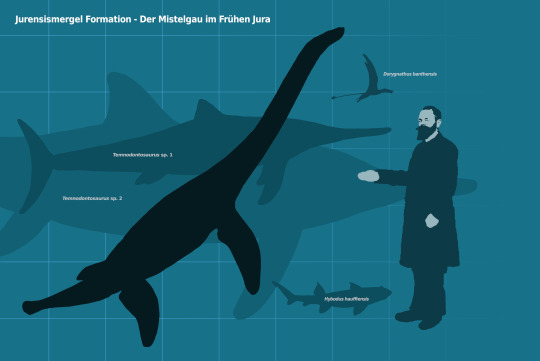
A little background for my illustration. The Jurensismergel appears to preserve largely a deep water environment but I wanted to show the animal not in a blue void or with some dark sludge near the bottom so I gave it a patch reef to rest on, sourced from some locally available Muschelkalk. The whole presentation is very much inspired by the collection of the Museum in Bayreuth. down to the Temnodontosaurus rostrum jutting out of the ground here. Saurichthys is known from the Jurensismergel but the Dapedium and other fish were burrowed from Posidonia.

when you zoom in you can see crustaceans climbing over and cleaning the Franconiasaurs.

#sciart#paleoart#palaeoblr#jurassic#plesiosaur#franconiasaurus#marine reptile#toarcian#ichthyosaur#posidonia shale#jurensismergel#fish
672 notes
·
View notes
Text
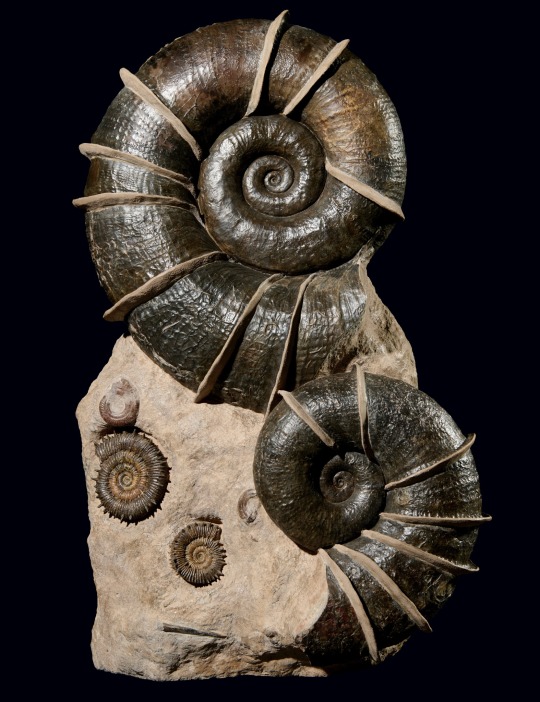
A "WINGED" AMMONITE GROUP
Specimens of Lytoceras cornucopia with ribbed "wings" preserved in original matrix with two spiny Ammonites,
Porpoceras verticosum from the Jurassic, Toarcian (circa 182 to 174 million years ago). 27” x 15” x 9”
Belmont, France
Christie’s
2K notes
·
View notes
Text

Some draft sketches I've had of the king of the dinosaurs, Tyrannosaurus rex. I had a lot of feedback and suggestions as to how to stylize. The beginning draft was inspired by the work of @toarcian.

This meanie head was inspired by the big red rex from the original Jurassic Park Kenner line.
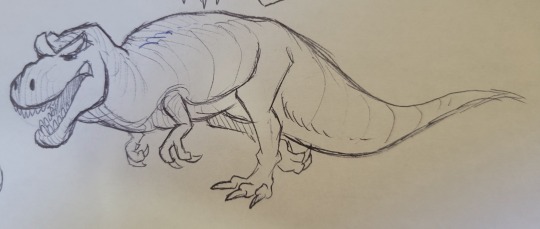
This lumpy meathead is definitely my favorite of the bunch, it's based on the DK model tyrannosaurus with its sagging belly and bizzarely proportioned body. It still needs some work tho.
#art#artwork#artists on tumblr#character art#character concept#dinosaur#paleoart#doodle#cartoon#sketches#sketch#dinosaurs#tyrannosaurus#tyrannosaurus rex#t rex#tyrannosaurid#theropod#jurassic park
127 notes
·
View notes
Text
Round One: Ngwevu vs Kholumalumo
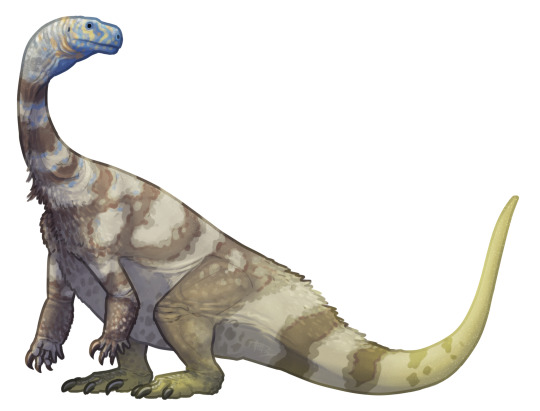

Factfiles:
Ngwevu ntoloko

Artwork by @i-draws-dinosaurs, written by @i-draws-dinosaurs and @zygodactylus
Name meaning: Grey skull
Time: ~190 to 180 million years ago (Pliensbachian to Toarcian stages of the Early Jurassic)
Location: Clarens Formation, South Africa
Ngwevu is a dinosaur with a case of baby-face so bad it was classified as another genus for 40 years. Initially discovered in 1978 and thought to be a specimen of Massospondylus, turns out it was just a really baby-looking prosauropod of a different kind! Many times in evolution animals will retain “baby” characteristics into adulthood - the classic and easily recognizable trait being large, round eyes, but also other features such as stunted proportions and chunkier limbs, depending. It seems that Ngwevu went through one of these processes, looking more similar to juveniles of other prosauropods (such as Massospondylus) than adults, all while actually being adults themselves. Predictably, it had a squat face with large eyes, a wide snout, robust proportions, and a thick body - babified Massospondylus! It probably had a more generalist diet than its cousin, indicating probable niche partitioning as the two lived in the same environment. The Clarens Formation, coming right after the Elliot, was an arid desert dominated by dunes, with a few types of dinosaurs including ornithischians, theropods, and other sauropodomorphs. In addition, fish, crustaceans, and invertebrates are also known from this location.
Kholumolumo ellenbergerorum

Artwork by @alphynix, written by @i-draws-dinosaurs
Name meaning: Kholumolumo (giant reptilian dragon from Sotho folklore) named for Paul and François Ellenberger (the original excavators of the fossils)
Time: 210 million years ago (Norian stage of the Late Triassic)
Location: Lower Elliot Formation, Lesotho
Kholumolumo is an old friend with a new name. Its previous informal name, “Thotobolosaurus” meaning “trash heap reptile”, was truly magnificent and became one of the great memes of Ye Olde 2010s Palaeo Tumblr! Needless to say it was a bittersweet moment to see our old buddy finally published but lose its iconic name in the process. Rest in peace, Trash Heap Lizard.
The reason it wound up with that name is because the fossils were in fact found basically right next to the local rubbish dump of the village of Maphutseng in 1955. The trash pile turned out to be sitting on a bone bed of around five to ten animals, and over the course of several years they were excavated and moved to the University of Cape Town. Unfortunately, and perhaps appropriately to the name, the subsequent study of these fossils ended up being a complete trash fire. Specimens went missing that have never been found, professional relationships fell apart, and the animal itself wasn’t mentioned in the literature until 1970 when it was dropped into a discussion on the stratigraphy of the Elliot formation and named “Thotobolosaurus mabeatae” without any description of the fossils. This made the name “Thotobolosaurus” a nomen nudum (naked name) and thus invalid.
Finally in 2020 all the tribulation paid off and it received a proper initial description, although many fossils that weren’t lost in the chaos still remain under study and could be the subject of future papers. It’s nice to see our beloved trash heap of a dinosaur finally coming into its own!
DMM Round One Masterpost
#dmm#dinosaur march madness#dmm round one#dmm rising stars#palaeoblr#dinosaurs#paleontology#bracket#march madness#polls#ngwevu#kholumalumo
170 notes
·
View notes
Text
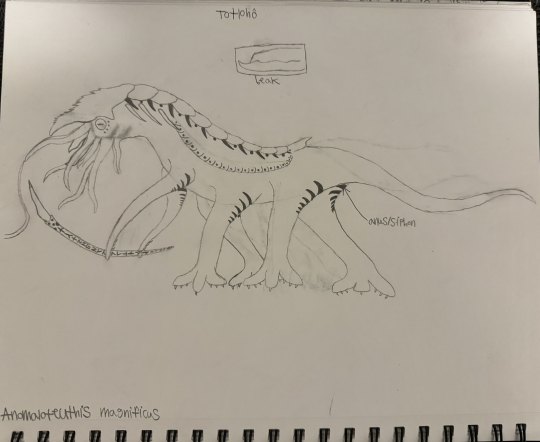
Totlohô
Kingdom: Animalia
Phylum: Mollusca
Class: Cephalopoda
Subclass: Nautiloidea
Superorder: Alysidaceratoidea
Order: Paratetrapoda
Superfamily: Cotylopodoidea
Family: Cotylopodidae
Subfamily: Anomaloteuthiinae
Genus: Anomaloteuthis
Species: A. magnificus (”magnificent unusual squid”)
Ancestral species: possibly Plectronoceras cambria
Temporal range: Early Jurassic (Toarcian) to Early Cretaceous (Hauterivian) (180 - 130 mya)
Information:
While humans have long seen themselves as the first and only sapient species to inhabit their planet, in all truth, there existed another in Xenogaea several hundreds of millions of years ago, one whose legacy can still be felt throughout the region untold eons later in their bizarre ruins and artifacts: the Totlohô-tu-Tẋusko/Tẋusko-tu-Totlohô (IPA: /to̞t͡ɬo̞hɔ tu t͡ʃusko̞/ OR /t͡ʃusko̞ tu to̞t͡ɬo̞hɔ/, meaning "ancestor of (the) architect"), better known as simply the Totlohô (/to̞t͡ɬo̞hɔ/, simply meaning "architect").
As soft tissues of this species have only rarely been preserved, and hard tissues consist only of armor plating and beaks, their size and general appearance alone must be inferred purely based on known proportions from living relatives, other members of the aberrant nautiloid clade Alysidaceratoidea, known more colloquially as the shrikehounds. The most reliable size estimate places them at around 12 feet long, 6-7 feet tall, and weighing close to 600 lbs. The appearance of these creatures, based on ancient stone murals, would seem to suggest that they were centaur-like in build, sporting six main limbs along with a menagerie of smaller tentacles around the face, which housed a long, narrow beak with a noticeable underbite. The exact coloration of this species isn’t known, though as murals exist which depict them, it can be inferred that they might have had a similar coloration pattern to living nautili, with a creamy-colored body and eyes with an earthy red shell and head piece.
Living shrikehound species are not particularly vocal, with only the paratetrapods having an analogue to proper vocal cords. This species was presumably vocal in some capacity, though the exact vocalizations cannot be deduced. It has been suggested that like their living relatives, they might have been able to produce clicks, grunts, warbles, rumbles, belches, screeches, and shrieks. It has been suggested, however, that they may have convergently evolved chromatophores like some of their living relatives and may have had a primarily visual language instead, one which has not, as of yet, been decoded.
Much of these organism's general biology is not known conclusively. Most evidence points to a carnivorous diet, consisting mainly of small dinosaurs/paravians, but also other terrestrial nautiloids, small mammals, and a bizarre group of terrestrial acanthodians known as coelospondyls. Though the exact place where they first evolved has yet to be conclusively found, fossilized beaks first appear in the Matansitra Formation in the southwest of the Isle of Perils, though later formations across the entire archipelago show that almost every habitable landmass sported a population of these creatures at one point. Dubious material from areas outside the archipelago, including what is now China and Australia, suggests they may have eventually left the archipelago at some point as well. At their peak during the Kimmeridgian age of the Late Jurassic epoch roughly 150 millions years ago, their population size was likely upwards of 40 million. Very little (if anything) can be inferred about their reproductive biology, though murals would seem to suggest that courtship and copulation was a very long, drawn-out process, treated almost as an art form unto itself. From their closest relatives, it can be inferred that the males, using a modified tentacle, deposited sperm into a small groove on the female’s underside, where it could be absorbed and used to fertilize the eggs. Their clutch size is believed to have been anomalously small compared to other species in their clade, possibly no more than 10 eggs at a time. The young appear to have matured at a similar rate to human young, if not slightly faster. Sexual dimorphism does not appear to be a prominent trait within their species.
Not much can be inferred about the behavior of this species from what remnants have been found, though it can be inferred that they were likely highly social creatures with complex social structures. They appear to have engaged in agrarianism and the farming of other animals in their later stages of societal development, as evidenced by a high correlation in dump beak remains found near dump sites for animal bones and shell, and even built cities. Murals would seem to suggest Totlohô society was ruled by a class of elders, the oldest respective members of their society, while the youngest members formed the work force. Song and dance appear to have been ways to bond with one another, and spirituality played a large part in their society’s function. Warfare appears to have been an isolated phenomenon in their society and frequently on a much smaller scale than as seen in humanity, though there exists some evidence of widespread warfare in the later years of existence. Even in their later stages, when they evidently had significantly advanced technology (or, as the more conspiracy-minded would suggest, magic of some kind), the Totlohô still preferred to build their homes out of stone.
During the later stages of their existence, the Totlohô appear to have dabbled in what appears to be highly-advanced technology or potentially even magic of some kind, as evidenced by massive, seemingly Totlhômade, carved, levitating stones covered in glyphs. In a place known as the Square Chasm (picture below, artwork by Dipfruit), a reportedly supernatural space some weary jungle travelers have stumbled upon near a triple-forked river, one of these stones appears to have formed a perfectly square-shaped pocket dimension around itself, where gravity itself appears to bend to the stone’s whim.

Fossilized beaks and hard shells are really the only physical parts of these creatures to have been preserved, and they are the only indication of their existence outside of aforementioned ruins and murals. Their written languages have yet to be decoded, and there are believed to have been several thousand at a given time. What exactly led to their extinction has yet to be conclusively revealed, though murals seem to suggest that, from their perspective, supernatural forces may have been at play, with recurrent imagery of what appears to be demonic figures showing up across several murals. Another recurrent image in these murals is a white bird-like creature with horns, which some have suggested may be related to the mythical white bird seen in Xenogaean mythology, which was said to herald the apocalypse. While some have suggested that these murals may have been painted by one of the last Totlohô, who had simply gone insane from isolation and began painting their hallucinations, others suggest that there might be a grain of truth in these murals, perhaps a war of apocalyptic scale which engulfed the entire species, the demagogues fueling it being portrayed as demonic figures. What this doesn’t explain, however, are the high number of artifacts which appear to be made from an unknown metallic substance, one which is highly durable and in near-pristine condition hundreds of millions of years later. This substance, referred to colloquially as “anomalous tungsten”, is paradoxically lightweight yet durable with a high melting point, seemingly higher than almost any other known metal or metalloid. As this metal has not been found anywhere on Earth or even in any known compounds on Earth or another planet, this begs the question of how and where the Totlohô obtained this substance, leading to a wide menagerie of conspiracy theories, with everything from extraterrestrials to divine beings being suggested as the source from which they obtained this material. Whatever the case, those who have studied the artifacts have claimed to have had vivid dreams where they spoke to the Totlohô shortly after contact. Perhaps this is just a form of confabulation or merely even group hysteria, but nonetheless, it would appear that even long after the Totlohô have left this world, their legacy still manages to touch the human spirit.
Finally, they appear to have domesticated a species of coelospondyl, Platycephale aridus, the so-called “flat-faced coelospondyl” (1st picture below, artwork by me), and another species of shrikehound, which is currently unnamed (2nd picture below, artwork by me). These appear to have been utilized as livestock animals.


#novella#speculative evolution#fantasy#scifi#scififantasy#speculative biology#speculative fiction#speculative zoology#worldbuilding#creature art#sophont#sci fi creature#creature design#fantasy creature#creative writing#creature#scifi worldbuilding#fantasy worldbuilding#nautiloid#nautilus#cephalopod#mollusk#cephalopods
15 notes
·
View notes
Text
Turnersuchus: First of the Sea Crocs
A big find for crocodile finds was revealed two days ago. Turnersuchus hingleyae (Hingley's and Turner's crocodile) is the oldest described and basalmost thalattosuchian described so far and is of great importance to slowly figuring out where thalattosuchians come from.
But lets start with a brief introduction to thalattosuchians. As the name already suggests, thalattosuchians are primarily known to have been marine animals (tho exceptions are known). thalattosuchians can broadly be split into two groups. The teleosauroids, which look somewhat similar to what one might call a normal crocodile, and the metriorhynchoids, which especially in the derived members could aptly be described as crocodile mermaids.
Below an example of each, on the left Macrospondylus by Nikolay Zverkov and on the right a generalized metriorhynchid by Gabriel Ugueto.

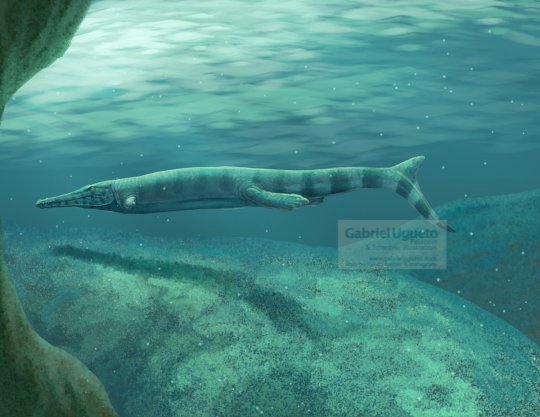
Thalattosuchians such as these two groups, which are sister clades and not successive lineages (so they co-occured rather than one having evolved from the other), were incredibly successful during the Jurassic, evolving enormous forms such as Plesiosuchus, Dakosaurus and Machimosaurus. Their wild success held on throughout the Jurassic until they eventually went extinct in the early Cretaceous. But despite how common and whidespread they are, we don't actually have much of a clue where they come from. Thalattosuchians just kinda appear during the Toarcian and are already found across multiple continents with both groups established. To complicate matters, their position among crocodiles is also rather shaky. Three main hypothesis exist. One is that they are a sister group to crocodyliforms (Protosuchians, Notosuchians and Neosuchians), that they are basal mesoeucrocodylians or that they are Neosuchians related to Pholidosaurids (like Sarcosuchus) and Dyrosaurs.
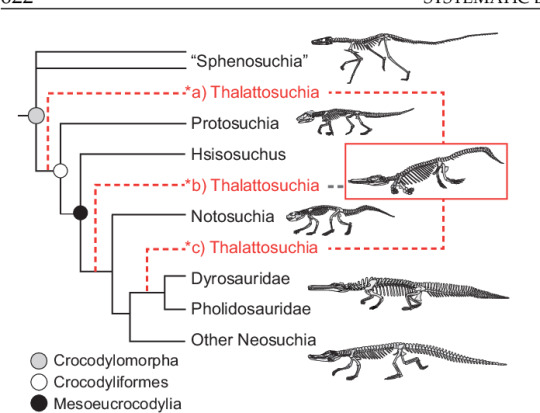
This is where Turnersuchus comes in. Discovered in the Charmouth Mudstone Formation of Dorset, England, this genus is known from the skeletal material belonging to the back of the head, mandible, parts of the forearms and shoulder girdle as well as neck, body and tail vertebrae all preserved in five blocks and a few isolated pieces of bone. From that we can already see general similarities to derived thalattosuchians and basic traits like narrow jaws and reduced forelimbs (tho not nearly as extreme as in metriorhynchids).
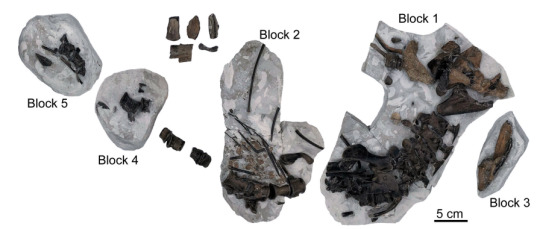
The first significant part about this discovery is its age. Turnersuchus is from the Pliensbachian stage of the Jurassic, so it predates any previously diagnostic thalattosuchians. Secondly is its position. As I said above, thalattosuchians are divided into teleosauroids and metriorhynchoids. But Turnersuchus is neither, with both phylogenetic analysis finding it to fall outside of these groups. Now in fairness this is not rock solid, as there is only a single trait excluding it from the derived groups in either analysis, so future works might shake things up. But as things are right now, it's the oldest named and basalmost member of the entire clade. On a sidenote at least the oldest part is bound to change, as the paper mentions a Moroccon teleosauroid currently in press that is even older.
All of this allows for two things. For one, by comparing Turnersuchus with the basal members of both teleosauroids and metriorhynchoids scientists were able to gather a list of traits that appear to be ancestral to the group. In addition, Turnersuchus also preserves some features that separate it from all other thalattosuchians that are also indicative of being an early member. Just as one example a specific part of the basioccipital thats associated with long skulls is poorly developed, which means that while slender the jaws weren't as long as in some later thalattosuchians. A Bayesian analysis was also conducted in an attempt to nail down when thalattosuchians evolved. Now depending on which phylogeny is used (one with thalattosuchians as non-crocodyliforms and another with them as mesoeucrocodylians) you get different times. The former would place their origin in the Norian stage of the Triassic, the later in the Sinemurian stage of the Jurassic. In light of the Moroccon material alluded to by the paper, it would appear that they likely split from other crocodylomorphs sometime in the late Triassic.
And finally to wrap this up let me share the press release artwork to finally give a face to all this information. Now if you've read my post about fossil crocs of 2022 you might already recognize the artist, as she's been on a real streak with illustrating fossil crocs. If you don't know her, I highly recommend checking out her work. I'm of course talking about Júlia d'Oliveira.

And yes, of course I got the Wikipedia page for it ready. Tho with work getting in the way when it was published I almost feared I'd be unable to get to it first.
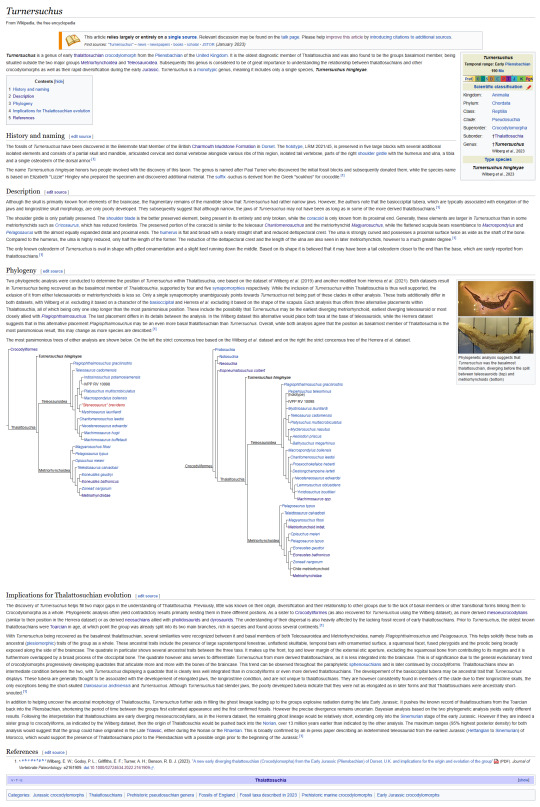
#turnersuchus#thalattosuchia#metriorhynchidae#teleosauridae#jurassic#paleontology#palaeblr#crocodylomorph#croc#pseudosuchian#marine reptile#long post#Wikipedia#paleontology news#crocodile
116 notes
·
View notes
Photo
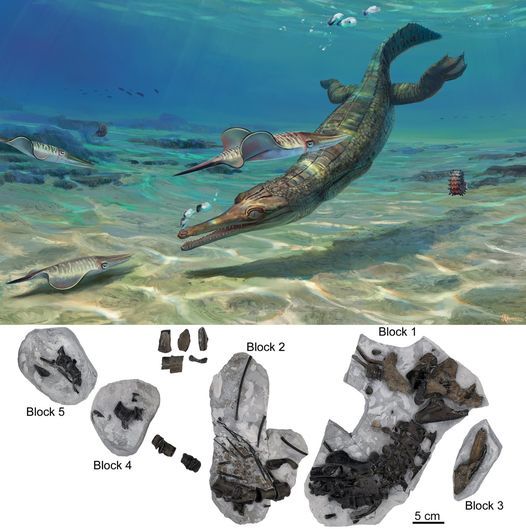
A new early diverging thalattosuchian (Crocodylomorpha) from the Early Jurassic (Pliensbachian) of Dorset, U.K. and implications for the origin and evolution of the group
Eric W. Wilberg,Pedro L. Godoy,Elizabeth F. Griffiths,Alan H. Turner &Roger B. J. Benson
ABSTRACT
Among archosaurs, thalattosuchian crocodylomorphs experienced the most extensive adaptations to the marine realm. Despite significant attention, the phylogenetic position of the group remains uncertain. Thalattosuchians are either the sister-group to Crocodyliformes, basal mesoeucrocodylians, or nest among longirostrine neosuchians.
The earliest definite thalattosuchians are Toarcian, and already possess many synapomorphies of the group. All phylogenetic hypotheses imply a ghost lineage extending at least to the Sinemurian, and a lack of older or more plesiomorphic forms may contribute to the uncertain phylogenetic placement of the group.
Here we describe a new species, Turnersuchus hingleyae, gen. et sp. nov., from the early Pliensbachian Belemnite Marl Member of the Charmouth Mudstone Formation (Dorset, U.K.). The specimen includes partially articulated cranial, mandibular, axial, and appendicular elements. It can be attributed to Thalattosuchia based on the following features: distinct fossa on the posterolateral corner of the squamosal; broad ventrolateral process of the otoccipital covering the dorsal surface of the quadrate; large supratemporal fenestrae lacking a flattened skull table; broadly exposed prootic; orbital process of quadrate lacking bony attachment with the braincase. This specimen represents the earliest thalattosuchian currently known from diagnostic material.
Phylogenetic analyses of two published datasets recover Turnersuchus as the earliest diverging thalattosuchian, and sister to Teleosauroidea + Metriorhynchoidea. Bayesian tip-dating analyses suggest a Rhaetian or Sinemurian divergence of Thalattosuchia from other crocodylomorphs, depending on topology, with confidence intervals spanning from the Norian to the Pliensbachian.
The new specimen extends the fossil record of Thalattosuchia, but the time-scaling analyses demonstrate that a significant ghost lineage remains.
Read the paper here:
https://www.tandfonline.com/doi/abs/10.1080/02724634.2022.2161909
23 notes
·
View notes
Text
Carpet sharks are sharks classified in the order Orectolobiformes /ɒrɛkˈtɒləbɪfɔːrmiːz/. Sometimes the common name "carpet shark" (named so because many species resemble ornately patterned carpets) is used interchangeably with "wobbegong", which is the common name of sharks in the family Orectolobidae. Carpet sharks have five gill slits, two spineless dorsal fins, and a small mouth that does not extend past the eyes. Many species have barbels.
The carpet sharks are a diverse group of sharks with differing sizes, appearances, diets, and habits. They first appeared in the fossil record in the Early Jurassic; the oldest known orectolobiform genera are Folipistrix (known from Toarcian to Aalenian of Belgium and Germany), Palaeobrachaelurus (Aalenian to Barremian) and Annea (Toarcian to Bajocian of Europe).[1] All species have two dorsal fins and a relatively short, transverse mouth that does not extend behind the eyes. Besides the nostrils are barbels, tactile sensory organs, and grooves known as nasoral grooves connect the nostrils to the mouth. Five short gill slits are just in front of the origin of the pectoral fin and the fifth slit tends to overlap the fourth one.[2] A spiracle occurs beneath each eye which is used in respiration. The only exception to this rule is the whale shark, the spiracles of which are situated just behind the eyes.[3] Carpet sharks derive their common name from the fact that many species have a mottled appearance with intricate patterns reminiscent of carpet designs. The patterning provides camouflage when the fish is lying on the seabed.[4] The largest carpet shark is the whale shark (Rhincodon typus) which can grow to a length of 14 m (46 ft). It is the largest species of fish, but despite its size, is not dangerous, as it is a filter feeder, drawing in water through its wide mouth and sifting out the plankton. The smallest carpet shark, at up to about 30 cm (12 in) long, is the barbelthroat carpet shark, (Cirrhoscyllium expolitum).[3] Some of the most spectacularly coloured members of the order are the necklace carpet shark (Parascyllium variolatum), the zebra shark (Stegostoma fasciatum), and the ornate wobbegong (Orectolobus ornatus). Nurse sharks and whale sharks have a fringe of barbels on their snouts, and barbelthroat carpet sharks (Cirrhoscyllium expolitum) have barbels dangling from their throat regions
@remen-nyoodless @chartreuse-blood
12 notes
·
View notes
Text
Warrior of sunlight, Ica
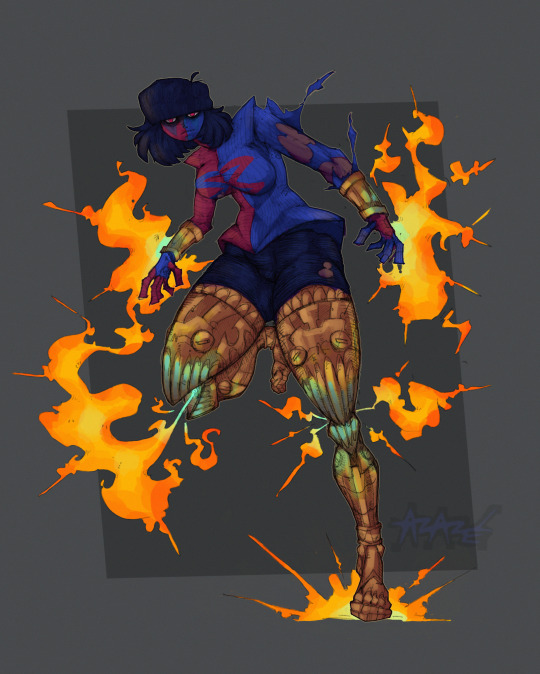
ica belongs to @toarcian
17 notes
·
View notes
Text
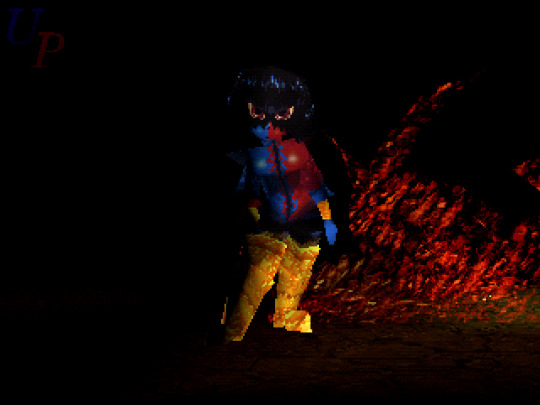
I modeled Ica, a character made by Toarcian.
#retro aesthetic#ps1#psx#3d#ica#lowpoly#blender#ps1 aesthetic#fire fire burns much brighter#when oxygen is the supplier
4 notes
·
View notes
Text
Perijasaurus lapaz Rincón et al., 2022 (new genus and species)

(Part of the type vertebra of Perijasaurus lapaz, with broken regions in orange and reconstructed regions or surrounding rock in yellow, from Rincón et al., 2022)
Meaning of name: Perijasaurus = Serranía del Perijá lizard [in Greek]; lapaz = La Paz [town near where the original fossil was discovered]
Age: Early or Middle Jurassic (Toarcian or Aalenian)
Where found: La Quinta Formation, Cesar, Colombia
How much is known: A single back vertebra.
Notes: Perijasaurus was an early sauropod, known from closer to the Equator than any other Early or Middle Jurassic sauropod. The type specimen of this dinosaur had been previously described in 1955, but was left unnamed at the time. Following a reexamination of the fossil, the authors of a new study gave it a name and reinterpreted it in light of what is now known about sauropod diversity. The only known vertebra of Perijasaurus is not as extensively hollow as those of later sauropods, suggesting that it represents an intermediate stage in the evolution of weight-saving features in sauropod vertebrae.
Reference: Rincón, A.F., D.A. Raad Pájaro, H.F. Jiménez Velandia, M.D. Ezcurra, and J.A. Wilson Mantilla. 2022. A sauropod from the Lower Jurassic La Quinta Formation (Dept. Cesar, Colombia) and the initial diversification of eusauropods at low latitudes. Journal of Vertebrate Paleontology advance online publication. doi: 10.1080/02724634.2021.2077112
#Palaeoblr#Dinosaurs#Perijasaurus#Early Jurassic#Middle Jurassic#South America#Sauropoda#2022#Extinct
25 notes
·
View notes
Photo

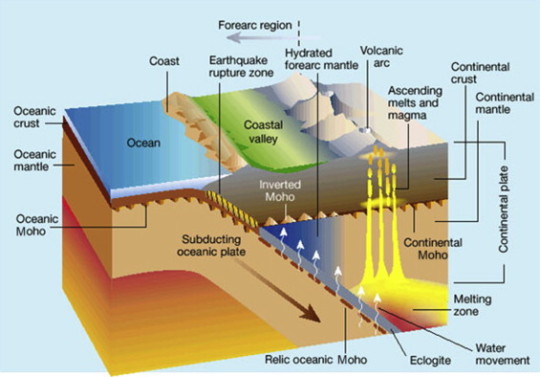
Surprising discovery shows a slowing of continental plate movement controlled the timing of Earth’s largest volcanic events Scientists have shed new light on the timing and likely cause of major volcanic events that occurred millions of years ago and caused such climatic and biological upheaval that they drove some of the most devastating extinction events in Earth’s history. Surprisingly the new research, published today in leading international journal Science Advances, suggests a slowing of continental plate movement was the critical event that enabled magma to rise to the Earth’s surface and deliver the devastating knock-on impacts. Earth’s history has been marked by major volcanic events, called Large Igneous Provinces (LIPs) – the largest of which have caused major increases in atmospheric carbon emissions that warmed Earth’s climate, drove unprecedented changes to ecosystems, and resulted in mass extinctions on land and in the oceans. Using chemical data from ancient mudstone deposits obtained from a 1.5 km-deep borehole in Wales, an international team led by scientists from Trinity College Dublin’s School of Natural Sciences was able to link two key events from around 183 million years ago (the Toarcian period). The team discovered that this time period, which was characterised by some of the most severe climatic and environmental changes ever, directly coincided with the occurrence of major volcanic activity and associated greenhouse gas release on the southern hemisphere, in what is nowadays known as southern Africa, Antarctica and Australia. On further investigation – and more importantly – the team’s plate reconstruction models helped them discover the key fundamental geological process that seemed to control the timing and onset of this volcanic event and others of great magnitude. Micha Ruhl, Assistant Professor in Trinity’s School of Natural Sciences, led the team. He said: “Scientists have long thought that the onset of upwelling of molten volcanic rock, or magma, from deep in Earth’s interior, as mantle plumes, was the instigator of such volcanic activity but the new evidence shows that the normal rate of continental plate movement of several centimetres per year effectively prevents magma from penetrating Earth’s continental crust. “It seems it is only when the speed of continental plate movement slows down to near zero that magmas from mantle plumes can effectively make their way to the surface, causing major large igneous province volcanic eruptions and their associated climatic perturbations and mass extinctions. “Crucially, further assessment shows that a reduction in continental plate movement likely controlled the onset and duration of many of the major volcanic events throughout Earth’s history, making it a fundamental process in controlling the evolution of climate and life at Earth’s surface throughout the history of this planet.” The study of past global change events, such as in the Toarcian, allows scientists to disentangle the different processes that control the causes and consequences of global carbon cycle change and constrain fundamental Earth system processes that control tipping points in Earth’s climate system. The research was conducted as part of the International Continental Drilling Programme (ICDP) Early Jurassic Earth System and Timescale (JET) project, and financially supported by the SFI Research Centre in Applied Geosciences (iCRAG), the Natural Environment Research Council UK (NERC), the National Science Foundation China, and the EU Horizon 2020 programme.
18 notes
·
View notes
Text

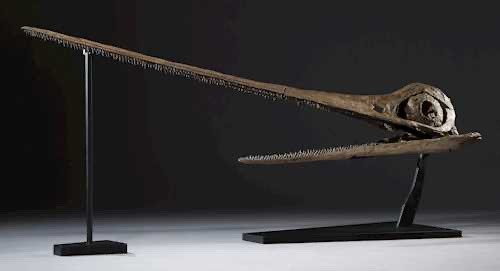
SKULL OF EURHINOSAURUS LONGIROSTRIS
The largest example ever discovered
Middle Toarcian, circa 180 million years
Holzmaden, Germany
227 × 45 cm
Eurhinosaurus (ancient Greek for ‘well-nosed lizard’) is an extinct medium-sized ichthyosaur genus of the Lower Jurassic (Toarcian) period of Europe. Eurhinosaurus first appeared in the Lower Toarcian and was last recorded in the Middle Toarcian, i.e. it lived about 180 million years ago.
Characteristic for the genus Eurhinosaurus is its extreme overbite. The lower jaw is about 60% shorter than the upper jaw. Dr Jürgen Riess (Dresden) assumes that Eurhinosaurus preferred ground-based feeding behaviour and that the long upper snout was a sensory organ which it would have used to track down its prey in the sediment. The synapomorphies also include the quadratojugal in a posterior position and smooth, pointed, narrow teeth. The orbit is remarkably large and round, and is the reason for the greatly reduced cheek region.
The skull presented here is extremely well-preserved. The mandible is almost completely intact with only 5% restoration. The rostrum is complete at 75%. The back of the skull is also very well preserved, with only minor restorations.
This skull was found in a very hard pyritised nodule in Germany. It took no less than ten months of preparation work by two talented palaeontologists to realise this project, resulting in a stunning work of natural art.
This is the largest skull known from this species in the world. We estimate the length of the full animal at over 32 ft (10 m): a true giant of the sea!
Koller
31 notes
·
View notes
Text
Fossilized Fish Found in Cattle Field
The fossilised remains of a Pachycormus fish (below) have been found in a cattle field in Stroud, Gloucestershire.
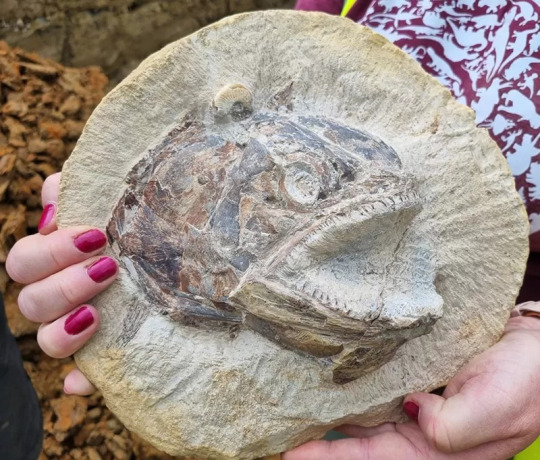
Found by Nevile and Sally Hollingworth (who are both noted for their exceptional ability to identify high return fossil areas) in a rich fossil seam running through a famers field, the fossil dates back 183 million years, a time when the land would have been submerged under tropical waters, known as the Toarcian stage of the Jurassic. This period of time is known for its excellent preservation of soft tissues.
Several more fossils were found in the same seam, including more fish, squids, and two ichthyosaurs. This is interesting as its a prime example of the full food chain. More interestingly, fossilised wood and insects have also been found in the seam, suggesting that land was close by.
The last time a comparable site was found was the Strawberry Bank Langerstatte in Somerset during the 1800's, marking an exciting step forward in the study of the Jurassic period.
Source (of information and image): BBC News, written by Jonathan Amos
2 notes
·
View notes
Text
Asfaltovenator vs Meraxes
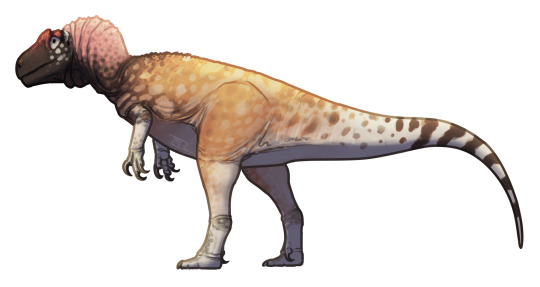

Factfiles:
Asfaltovenator vialidadi

Artwork by @i-draws-dinosaurs, written by @raptorcivilization
Name meaning: Hunter of the Cañadón Asfalto Formation, thanks to the Vialidad Nacional
Time: 179 to 178 million years ago (Toarcian stage of the Early Jurassic)
Location: Cañadón Asfalto Formation, Argentina
On the surface Asfaltovenator might look like just a generic carnosaur. Which it kinda is - being at around the base of Carnosauria. But it’s a pretty good basal carnosaur. It’s known from a single individual, but the entire front half of the body was recovered - complete head, neck, arms, and torso. Which is pretty cool. What’s even more interesting is that it displays a blend of anatomical features that had previously been considered unique to different tetanuran lineages (megalosauroids, carnosaurs, and coelurosaurs). Because of this, in the the phylogenetic analysis from its description, it dragged megalosauroids back into Carnosauria. First time that happened in a couple decades, which is neat. It even kinda looks like a retro carnosaur, in my opinion at least. At an estimated 25 feet long, while not huge, it was one of the largest predatory dinosaurs on the planet at the time. It lived alongside other early members of diverse Jurassic-Cretaceous dinosaur groups, including Eoabelisaurus, Bagualia, and Volkheimeria, as well as several mammals, a rhynchocephalian, the hallopodid crocodylomorph Almadasuchus, turtles, frogs, and the pterosaur Allkaruen.
Meraxes gigas

Artwork by @i-draws-dinosaurs, written by @zygodactylus
Name Meaning: Giant Dragon
Time: 95 million years ago (Cenomanian stage of the Late Cretaceous)
Location: Huincul Formation, Patagonia, Argentina
Giganotosaurs keep having new family members added to the group, and this one, Meraxes, is actually known from a decent amount of fossil material! Woo! Raching tern meters in length and known from parts of the limb bones, the skull, ribs, and vertebrae that show Meraxes was very similar to other Carcharodontosaurs, such as Acrocanthosaurus, in terms of limb proportions. It had the shortened forelimbs similar to other large carnivorous dinosaurs, indicating that this trait was selected for in large theropods on a repeated basis. It had a huge claw on its second toe, twice as long as the fourth toe claw. Having died sometime between 39 and 53 years of age, Meraxes is also one of the longest-lived nonavian theropods known, extending its growth period through its life in order to grow to larger sizes. Living in the arid, seasonal floodplain environment of the Huincul Formation, Meraxes lived alongside a wide variety of other dinosaurs, including Argentinosaurus, Cathartesaura, Choconosaurus, Chucarosaurus, Limaysaurus, Taurovenator, Mapusaurus, Gaulicho, Aoniraptor, Skorpiovenator, Tralkasaurus, Ilokelesia, Huinculsaurus, Overoraptor, and other fragmentary taxa.
DMM Round One Masterpost
#dmm#dinosaur march madness#dmm round one#dmm rising stars#palaeoblr#dinosaurs#paleontology#bracket#march madness#polls#asfaltoveantor#meraxes
129 notes
·
View notes
Photo
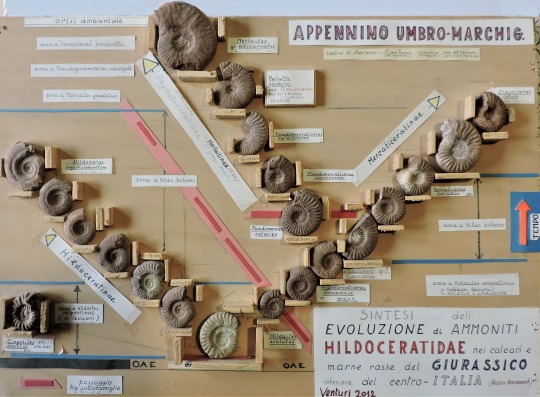
Source by: Paolo Faraoni
Link: Web
FEDERICO VENTURI - 1940-2020 was one of the most important scholars of Italian ammonites. Professor at the University of Perugia, he is the author of numerous scientific publications where he has established dozens of new genera and species of ammonites. He used his great skill in drawing a lot and also delighted in building beautiful tables in wood summarizing the evolutions of genera and species of the Toarcian ammonites. The table below illustrates the evolution of the Hildoceratidae. It was a great fortune to meet him, study with him and publish several scientific works together.
0 notes